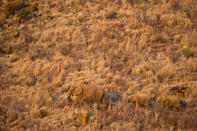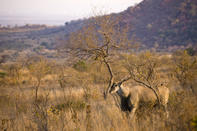The Park's Geological Biography
Stop your car at Lenong View lookout point and gaze at the park’s geological biography laid out before you. Below, lie the remains of a volcanic caldera. The mountains around you were once boiling magma, forced up through concentric cracks in the earth’s crust during the eruption, which was more a mighty implosion.

The resultant ‘ring dykes’ are now weathered, circular, verdant hills – ancient, even in geological terms. To the left is Mankwe Dam, the core of the old volcano. Directly below, ant-like giraffes stride towards Makorwane Dam. Up on the sourveld mountaintop, among rock fig and boekenhout, the breeze is cool, inviting. You could sit there all day, drinking in the sights.
Mankwe Plain

It’s late afternoon and the land is green and golden. A sizeable herd of elephants graze on Mankwe Plain. Young ones joust, older folks bathe in glutinous mud, babies raise periscopic tusks above the sea of grass. Beyond the elephants and stretching across the plain are herds of fat, flourishing zebra and wildebeest, many with cavorting young.
A group of six white rhinos approaches the car. One placid fellow almost headbutts the bumper. He looks at you with a myopic, bulbous-headed gaze. In the long grass all about, yellow-crowned bishop fluff balls drone from blade to blade like outsize bumblebees.
Pilanesberg at a Glance

Geologically, the Pilanesberg National Park Alkaline Ring Complex was formed by volcanic eruptions 1,300 million years ago. There are only two other alkaline volcanoes in the world (in Russia and Greenland), but Pilanesberg is the most clearly defined. In more recent history the area was home to the Tswana until the 1970s, when the park was founded.
Operation Genesis saw enormous numbers of animals translocated from all over Southern Africa. Situated in the ‘transition zone’ Bushveld, Pilanesberg boasts animals, birds and vegetation that occur in dry Kalahari as well as those from Lowveld regions.
Thus springbok, brown hyena, African red-eyed bulbul and camelthorn trees usually found in arid areas cohabit with wetter-area species such as impala, dark-capped bulbul and Cape chestnut.
By Justin Fox Safari near Sun City Resort. Just a few hours out of the hustle and bustle of Johannesburg you’ll find Pilanesberg National Park, a wildli...
Safari near Sun City Resort. Just a few hours out of the hustle and bustle of Johannesburg you’ll find Pilanesberg National Park, a wildli... The North-West has much to offer: treasure routes and heritage sites; premium game lodges and national parks; meteorites and prehistoric sku...
The North-West has much to offer: treasure routes and heritage sites; premium game lodges and national parks; meteorites and prehistoric sku...